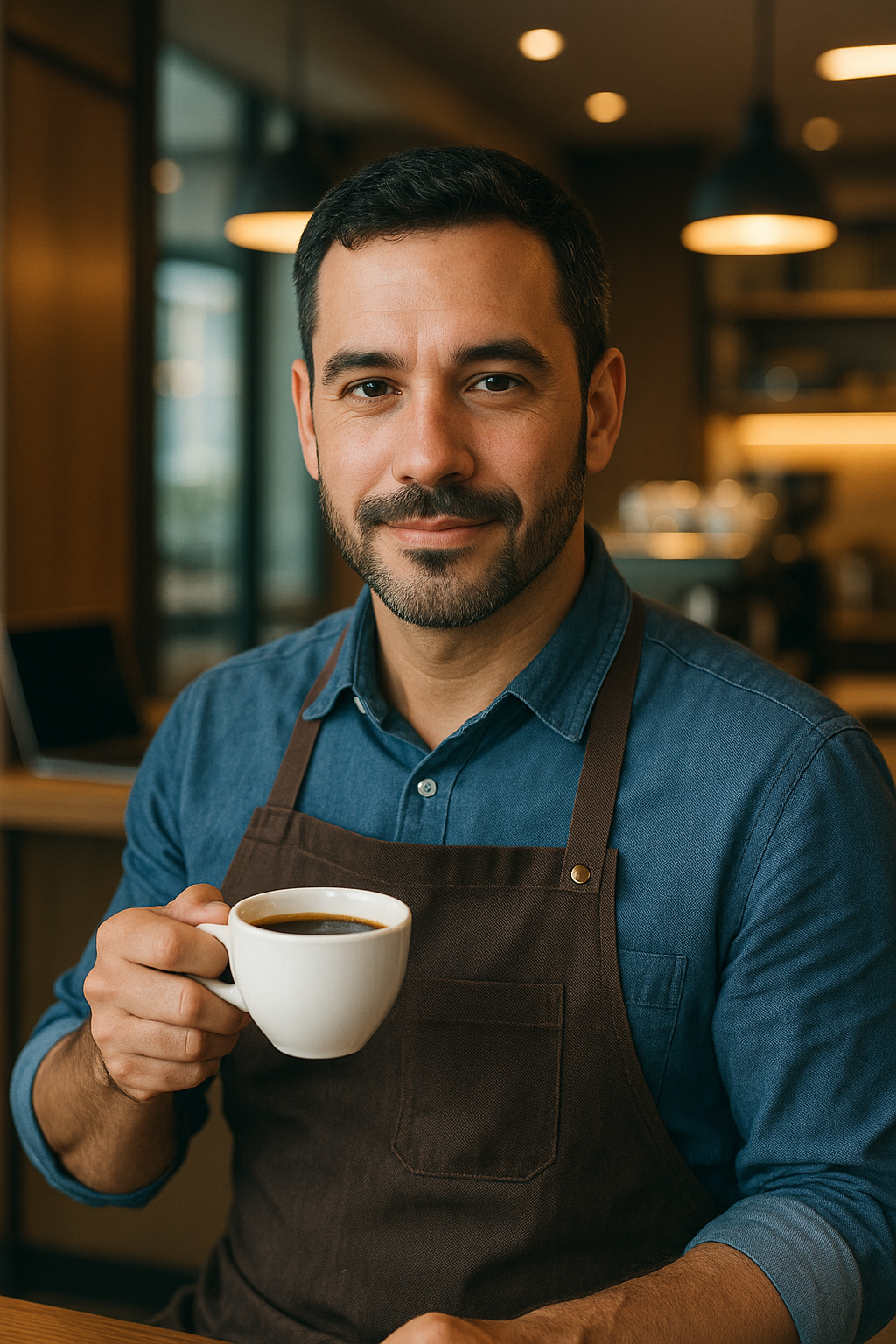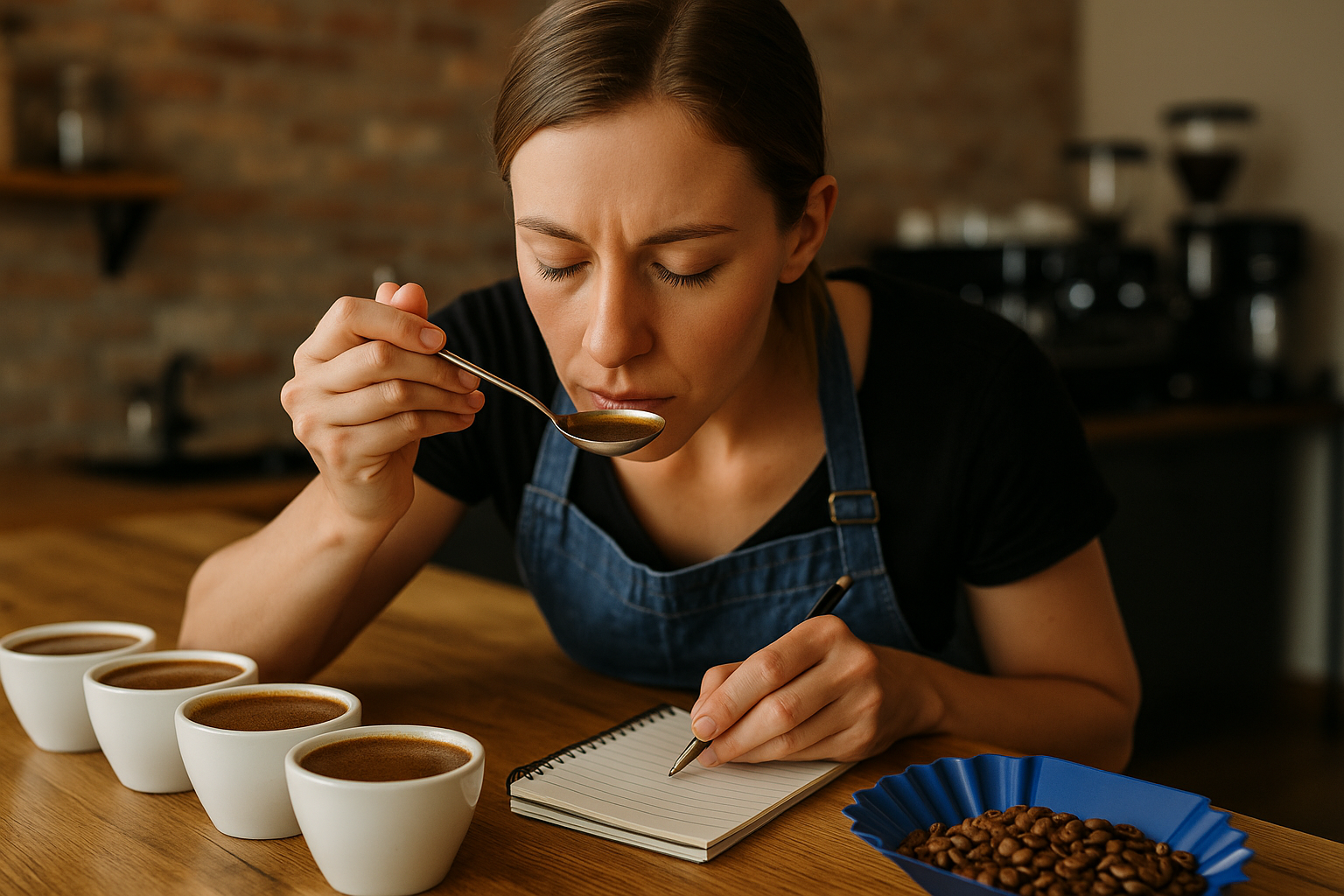A barista’s most important tool isn’t just a tamper or a grinder—it’s their palate. The ability to taste and describe coffee accurately is essential for dialing in espresso, choosing beans, and serving customers with confidence.
Great baristas train their palate like a musician trains their ear, gradually developing the sensitivity to detect balance, nuance, and defects in every cup they serve.
Coffee is one of the most chemically complex beverages on earth, containing over 800 volatile aromatic compounds.
This means it has a massive range of flavors—from bright citrus and berries to dark chocolate, nuts, herbs, and spices.
Learning to recognize these notes takes time, intention, and practice. But once developed, your palate becomes your guide in every aspect of brewing.
Why Palate Training Matters for Baristas
Tasting is not just a personal skill—it’s a professional requirement. A well-trained palate helps baristas identify under or over-extraction, detect defects in beans or roast profiles, and explain flavors to customers with confidence. It’s what allows a barista to serve consistently excellent coffee, even as variables change.
In specialty coffee, consistency is king. If you can’t taste when something is off, you can’t fix it. Customers notice when their drink doesn’t taste like it did the day before. Your palate gives you the power to diagnose problems and correct them on the spot—without guesswork.
The Five Basic Tastes and How Coffee Expresses Them
Your tongue detects five primary tastes: sweet, sour, salty, bitter, and umami. In coffee, sweet and sour are typically the most desirable, while bitterness and saltiness need to be balanced. Understanding these elements is the first step to developing your tasting vocabulary.
Sweetness in coffee often resembles caramel, honey, or chocolate. It comes from well-developed sugars in the roasting process.
Acidity (sourness) adds brightness and fruitiness, often compared to citrus or berries. Bitterness, though natural in coffee, becomes unpleasant when excessive. A great cup balances all these elements with clarity and harmony.
Aroma: Where Flavor Begins
Much of what we call “flavor” is actually aroma. Your nose detects volatile compounds before your tongue does.
That’s why cupping and tasting exercises begin with smelling dry grounds, then wet aroma after brewing. The more aromatic complexity a coffee has, the richer its flavor profile.
When practicing, close your eyes and focus on the scent. Try to identify categories first—fruity, nutty, floral, spicy—then go deeper. Is it more like lemon or orange?
Is the nutty note almond or hazelnut? This level of awareness translates directly to how you describe and evaluate each coffee.
How to Cup Coffee Professionally
Cupping is the industry-standard method for evaluating coffee. It uses immersion brewing with no paper filter to allow full flavor clarity.
Start by grinding each sample fresh and coarsely, placing 8.25g in a 150ml cupping bowl. Add hot water (around 93°C or 200°F), and let it steep without stirring.
After four minutes, break the crust of grounds with a spoon while inhaling deeply. This is the wet aroma stage—critical for capturing volatile aromatics.
Skim the grounds from the surface and wait a few more minutes for cooling. Taste by slurping from a cupping spoon to aerate the coffee and spray it across your tongue.
Use a tasting form to note aroma, acidity, body, sweetness, aftertaste, and balance. Score each attribute. Over time, you’ll build a reference memory of how different origins, processes, and roasts affect taste.
Describing Flavor Notes
To describe coffee accurately, you need a flavor vocabulary. Start with the SCA Flavor Wheel—an industry tool that breaks flavors into families like “fruity,” “spice,” “floral,” and so on. Each branch leads to more specific terms like “stone fruit,” “clove,” or “jasmine.”
Don’t worry about sounding fancy. Use words that are clear and specific. Instead of saying “nice,” say “cocoa-like with mild citrus acidity.” Instead of “weird,” try “strong fermentation note with winey fruit.” Practice this until it becomes second nature. The goal is clarity, not poetry.
Taste Calibration With Others
Tasting is subjective, but calibration makes it objective enough to work as a team. In a café, all baristas should taste and agree on the flavor profile of each bean. If one person finds it too sour and another too sweet, it’s time to review the recipe or technique.
Taste calibration builds trust and quality control. Use blind tasting sessions to train together. Compare notes, discuss differences, and identify why one person may perceive more bitterness or less sweetness. Sensory alignment is key to delivering consistent experiences to customers.
Sensory Training at Home
You don’t need a lab to train your palate. Start at home by tasting different fruits, spices, chocolates, and teas. Make it a habit to describe everything you eat or drink. Build a mental library of flavors and how they present in texture, aroma, and finish.
You can also use flavor kits designed for sensory training. These kits include vials of common coffee aromas (like leather, almond, black currant) to help you recognize them during cupping. Repetition is key—your brain learns through repeated exposure and association.
Common Coffee Defects and Their Taste
Part of palate training is recognizing what’s wrong. Common defects include:
- Fermenty: Overripe or poorly processed coffee. Tastes like vinegar, wine, or alcohol.
- Baggy: Old or improperly stored beans. Tastes like cardboard or dust.
- Quakers: Unripe beans that roast unevenly. Tastes like peanuts or cereal.
- Acrid: Over-roasted coffee. Tastes burnt, ashy, or medicinal.
Identifying defects helps baristas choose better beans and improve quality control. It also builds your confidence in explaining why a coffee isn’t up to standard.
Understanding Regional Flavor Profiles
Different origins produce different flavor characteristics due to altitude, soil, varietals, and processing methods. For example:
- Ethiopian: Floral, tea-like, with bright citrus or stone fruit.
- Colombian: Balanced, sweet, with caramel and nutty tones.
- Kenyan: Bold acidity, juicy, with notes of blackcurrant or tomato.
- Brazilian: Low acidity, chocolatey, nutty, creamy body.
Learning regional profiles helps you anticipate flavors and compare coffees more effectively. It also enhances your storytelling ability when talking to customers.
The Role of Processing in Taste
Coffee processing affects flavor just as much as origin. The three main methods—washed, natural, and honey—each bring different characteristics:
- Washed: Clean, bright, with clarity in acidity and flavor.
- Natural: Fruity, winey, with heavier body and ferment notes.
- Honey: A mix of both—sweet, syrupy, with mild acidity.
As a barista, tasting different processes trains your palate to distinguish these characteristics and match them with brewing methods that highlight their best traits.
Temperature and Flavor Perception
Coffee flavor changes as it cools. Many notes become more prominent at lower temperatures, especially acidity and sweetness. That’s why professional tasters evaluate coffee at multiple stages—hot, warm, and cool.
Train yourself to notice how your perception evolves during the cooling curve. Some coffees taste better at 60°C than at 80°C. Learn to identify how flavor notes emerge and fade. This helps you recommend ideal drinking temperatures to customers for the best experience.
The Emotional and Cultural Side of Tasting
Flavor isn’t only technical—it’s emotional. Memory and culture affect how we perceive and describe taste. A tropical fruit note might remind one person of vacation and another of childhood snacks. Being aware of this helps you connect with others during tastings and build empathy into your descriptions.
When serving customers, use relatable language. Instead of saying “papaya,” say “tropical and juicy, like a mango smoothie.” Adjust based on their experience level. Your goal is to make tasting enjoyable and accessible—not intimidating.
Tasting and Menu Design
Baristas who understand flavor deeply can help design better café menus. You’ll know which beans work better in espresso versus filter, which ones pair well with milk, and how to balance offerings across origins and roast profiles.
You can also guide seasonal rotations, offering brighter coffees in summer and richer ones in winter. Flavor literacy gives you a voice in shaping your café’s identity—and its success.
Practice Builds Sensory Confidence
You don’t need to be a certified Q Grader to have a great palate. What matters is consistent practice and curiosity.
Taste everything. Take notes. Ask questions. Trust your senses, but also challenge them. The more you train, the more confident and useful your palate becomes.
Start with one coffee. Taste it every day for a week. Brew it differently, taste it at different times. Try it with and without milk. This depth of engagement teaches you more than 50 casual tastings ever will.
The Barista’s Superpower
Developing your palate is the single most valuable investment you can make as a barista. It enhances every part of your craft—from brewing to customer service.
It turns coffee from a job into an exploration. It connects you to the bean, the farmer, and the customer in a meaningful, sensory way.
Taste is your superpower. Train it, trust it, and use it to make every cup exceptional.

Marcelo Oliveira is a coffee enthusiast and content creator specializing in barista skills, brewing methods, equipment reviews, coffee-related health insights, and fascinating curiosities from the coffee world. With a deep passion for every step of the brewing process, he turns technical knowledge into accessible and engaging content for both beginners and seasoned coffee lovers. Marcelo’s goal is to help readers appreciate the full experience of coffee—from bean to cup.
